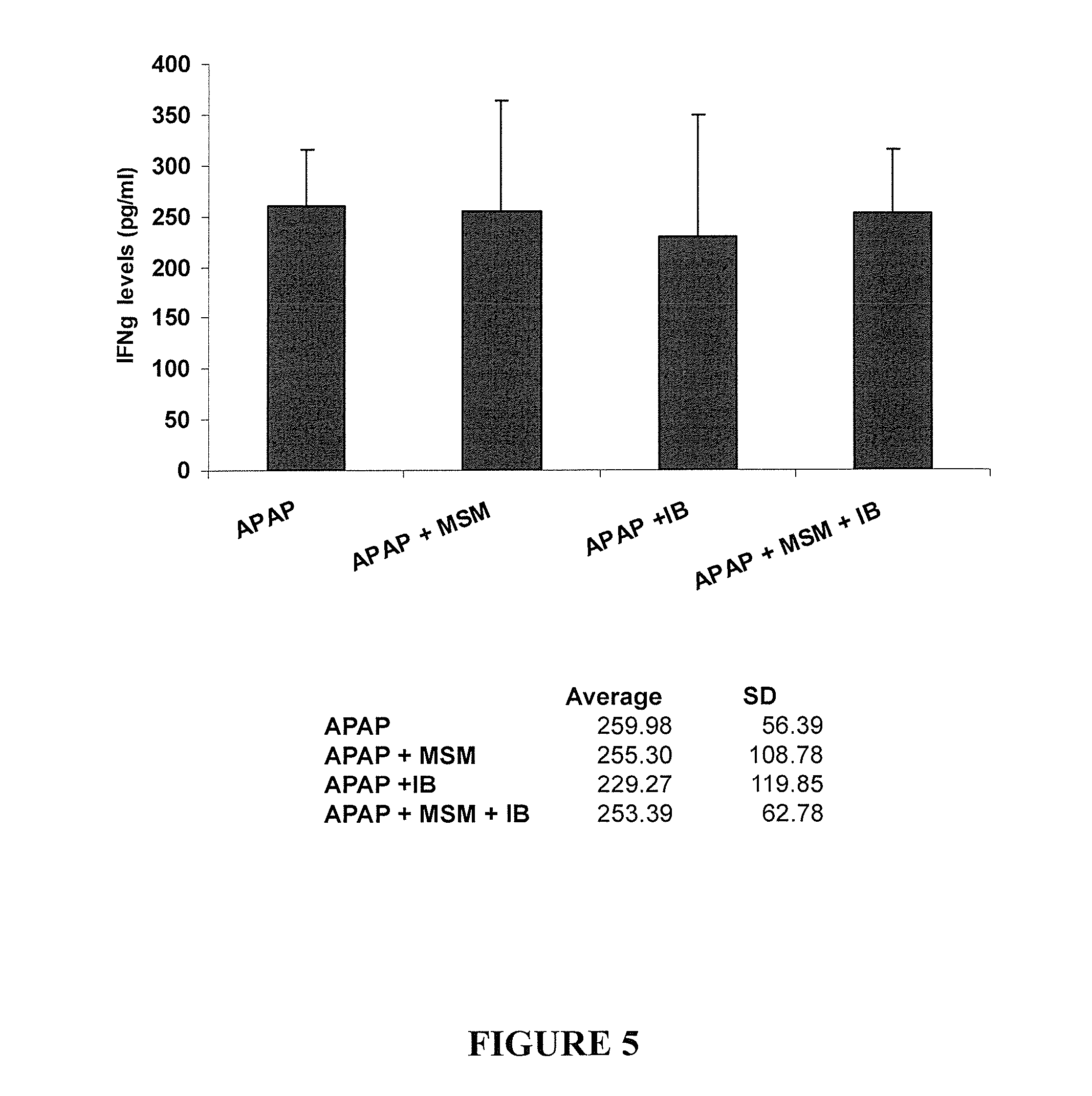Compositions And Methods For Amelioration And Prevention Of Drug-Induced Toxicity
- Summary
- Abstract
- Description
- Claims
- Application Information
AI Technical Summary
Benefits of technology
Problems solved by technology
Method used
Image
Examples
example 1
Isosilybin B (IB)
[0165]IB was tested for its effect on toxicity induced by APAP in comparison to NAC using the following procedure: Mice were allocated into four groups of six mice each, as described in Table 1 below. The mice received sub-lethal hepatotoxic doses of APAP, causing liver damage equivalent to consumption of approximately 10 gr APAP (20 caplets of 500 mg) per 70 kg man.
TABLE 1Groups and treatment regimensDosageGroupNTreatment(for treatment)Admin.fastingA6APAP4 mg / mousePOyesB6APAP +APAP - 4 mg / mousePOyesNACNAC - 3 mg / mouseC6APAP +APAP - 4 mg / mousePOyesIBIB - 0.4 mg / mouseD6APAP +APAP - 4 mg / mousePOyesIBIB - 0.2 mg / mouseE6APAP +APAP - 4 mg / mousePOyesIBIB - 0.1 mg / mouse
[0166]Mice were treated according to the following procedure:
[0167]Food was taken on the afternoon (18:00) of Day 0. Mice were orally administered APAP, APAP+IB or APAP+NAC 15 h hours later (9:00 next morning, Day 1) by gavage administration. A total of 350 μl were administered, containing the different comp...
example 2
Comparative
[0171]The following combinations were tested using the same procedure described in Example 1 above, and compared to 4 mg APAP+3 or 3.5 mg NAC:
[0172]4 mg APAP+0.1 mg Isosilybin A (IA)
[0173]4 mg APAP+0.2 mg IA
[0174]4 mg APAP+0.4 mg IA
[0175]4 mg APAP+0.1 mg silybin B
[0176]4 mg APAP+0.4 mg silybin B
[0177]The results are summarized in Tables 3 and 4.
TABLE 3Serum levels of liver enzymes (IU / L)ALTASTGroup(average_ ± std. dev.)(average_ ± std. dev.)4 mg APAP5,617.50 ± 1,832.773,672.67 ± 1,965.994 mg APAP +1,050.25 ± 1,248.132,717.33 ± 3,314.473 mg NAC4 mg APAP +7,010.00 ± 1,952.854,720.67 ± 1,909.820.4 mg IA4 mg APAP +6,976.75 ± 4,473.265,349.33 ± 3,537.580.2 mg IA4 mg APAP +8,002.50 ± 2,122.655,468.00 ± 1,986.150.1 mg IA
TABLE 4Serum levels of liver enzymes(IU / L)ALTASTGroup(average ± std. dev.)(average ± std. dev.)4 mg APAP8,880.00 ± 2,624.315,848.67 ± 1,993.434 mg APAP +807.00 ± 706.48816.40 ± 501.923.5 mg NAC4 mg APAP +7,217.50 ± 3,466.484,610.00 ± 2,764.220.4 mg silybin B4 mg ...
example 3
IB in Combination with NAC
[0179]A combination of IB and NAC was tested for its effect on toxicity induced by APAP using the same procedure described in Example 1 above. Mice were allocated into four groups of six mice each, as detailed in Table 5 below. Food was taken on the afternoon (18:00) of Day 0. Mice were orally administered APAP, APAP+NAC or APAP+NAC+IB 15 hours later (9:00 next morning, Day 1) by gavage administration. Food was returned 2 h after APAP administration (Day 1).
TABLE 5Groups and treatment regimensDosageGroupNTreatment(for treatment)Admin.fastingA6APAP4 mg / mousePOyesB6APAP +APAP - 4 mg / mousePOyesNACNAC - 3.5 mg / mouseC6APAP +APAP - 4 mg / mousePOyesNAC +NAC - 3.5 mg / mouseIBIB - 0.4 mg / mouseD6APAP +APAP - 4 mg / mousePOyesNAC +NAC - 3.5 mg / mouseIBIB - 0.1 mg / mouse
[0180]For all groups, mice were weighted daily, and blood samples were taken 24 h hours after APAP administration (Day 2) for liver enzyme tests. In addition, liver biopsies were performed. For histopathology...
PUM
| Property | Measurement | Unit |
|---|---|---|
| Composition | aaaaa | aaaaa |
| Toxicity | aaaaa | aaaaa |
Abstract
Description
Claims
Application Information
 Login to View More
Login to View More - R&D
- Intellectual Property
- Life Sciences
- Materials
- Tech Scout
- Unparalleled Data Quality
- Higher Quality Content
- 60% Fewer Hallucinations
Browse by: Latest US Patents, China's latest patents, Technical Efficacy Thesaurus, Application Domain, Technology Topic, Popular Technical Reports.
© 2025 PatSnap. All rights reserved.Legal|Privacy policy|Modern Slavery Act Transparency Statement|Sitemap|About US| Contact US: help@patsnap.com



